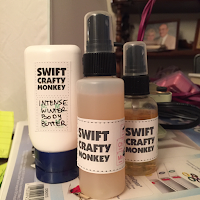Newbie Tuesday: Creating a facial toner, part two

Last week we started making toners. This week, we'll modify them using some of the interesting ingredients we can get from our suppliers.
As an aside, there's nothing wrong with a simple toner of rose water or witch hazel plus preservative. Simple can be just as awesome as super and ridiculously complicated, so don't stress if you've made something you love and want to leave it that way.
In the shopping list, I suggested a few ingredients you could use in this series, so let's take a look at how to integrate them into a toner.
Humectants are awesome ingredients. They draw water from the atmosphere to your skin to hydrate and moisturize. In toners, we could use glycerin, sodium lactate, sodium PCA, hyaluronic acid, sorbitol, propylene glycol, butylene glycol, honeyquat, and more. A little goes a long way. We can use as little as 0.1% hyaluronic acid, 2% glycerin or sodium lactate, 2% sodium PCA, 3% honeyquat, and so on in our products to offer that great hydration we want on our skin.
Hydrolyzed proteins are a great way to hydrate your skin with just a titch of an ingredient. I've suggested that you try using hydrolyzed oat protein and silk amino acids or silk protein in this series, but there are so many more.to choose from like baobab*, rice*, quinoa*, pea, lupine, soy*, or Phytokeratin, a mix of corn, wheat, and soy. You can find them listed as hydrolyzed proteins, hydrolysates, amino acids, We'll use these in small amounts - 2% to 5%, generally - in th...
Fuente de la noticia:
Point of Interest
URL de la Fuente:
http://swiftcraftymonkey.blogspot.com
| -------------------------------- |
|
|
Dry Skin Savior: A Winter Skin Care Routine You Need Now
31-10-2024 07:16 - (
beauty )
Ulta Black Friday Has Already Started Have You Shopped"
31-10-2024 07:04 - (
cosmetics )















